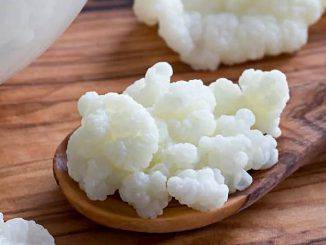
How long should I let my milk Kefir ferment until it’s ready? This is one of the questions I read quite often in most Kefir dedicated Facebook groups or forums.
The answer that is usually given to this question is “between 12 and 24 hours” and, indeed, this answer is not far from the truth. However, things are more complex than that and, in our opinion, a more realistic answer would be “it depends”.
Indeed, the duration of Kefir’s fermentation until it’s ready to be consumed highly depends on at least three factors:
- The ambient temperature.
- The Kefir grains to milk ratio.
- Your personal taste.
The ambient temperature
The temperature has a really dramatic impact on the time Kefir needs for its full ripening.
You have probably noticed that on cold winter days your Kefir brew needs much more time to be “fully ready” than in the hot summers. On the very hot summer days sometimes Kefir needs less than 10 hours to start separation which is a sure sign of overfermentation. On the opposite, on the cold days of winter, even if our kitchen is heated, Kefir needs more than 24 hours until fully fermented.
As we know from the natural science classes, ambient temperature has a direct impact on the speed of all biological processes. Higher temperatures tend to speed up all processes, while low temperatures tend to slow down all processes up to a complete standstill.
The same rules apply to Kefir’s fermentation. Hither temperatures tend to speed up Kefir’s fermentation and shorten the time needed for its full ripening, while lower temperatures tend to slow down Kefir’s fermentation and prolong its ripening time.
However, the ambient temperature doesn’t have an impact on the ripening time only. It also affects the microbial content of the resulting Kefir.
Since tower temperatures act in favor of the bacteria at the expense of the yeasts, slower fermentation also gives Kefir a smoother consistency, because of the predominance of bacteria over the yeasts which makes Kefir thicker. That is the reason why fermenting Kefir in the fridge usually results in a thicker and tastier Kefir.
So, remember that higher temperatures will not only considerably speed up the fermentation of your Kefir, but will also act in favor of the yeast predominance in your Kefir brew.
Alternatively, lower temperatures will not only slow down the fermentation of your Kefir but will also favor the development of bacteria in your Kefir brew thus making it thicker and tastier. This is the reason why we will always advise you to carry the second ferment of your Kefir in the fridge.
The Kefir grains to milk ratio
The number of Kefir grains in for a given quantity of milk is also crucially important for the duration of the fermentation.
The “normal concentration” of Kefir grains is about a tablespoon of grains for each quarter gallon (about a liter) of milk. However, as we know, the kefir grains tend to reproduce and multiply with each batch, so with each Kefir brew, the volume of the grains tends to exceed the number perceived as “normal”.
The number of Kefir grains, however, also affects the duration of the fermentation. The more grains you add to a given quantity of milk, the faster it ferments.
It usually takes just a couple of batches until the initial volume of Kefir grains you put in your quarter of milk actually doubles. As result, your next batch will ferment twice as fast!
So, if you want to keep the fermentation time within reasonable limits, don’t forget to either remove the excess grains or add more milk to the batch. Otherwise, your Kefir brew will ferment faster with each batch.
Your personal taste
There are no two persons on this planet that have the same taste as there is nothing more individual than taste.
Some people may find Kefir “ready” after just 6 or 7 hours of fermentation, while to others Kefir may appear “fully ripened” after no less than 48 hours of fermentation. It all depends on personal taste.
Usually, a good sign that your Kefir is “ready” is the appearance of the first small pockets of whey. These are the first sign of Kefir’s separation, and full separation of Kefir usually means over fermentation.
Note, however, that over-fermented Kefir doesn’t necessarily mean a “spoiled” or “bad” Kefir. Quite the opposite – fermentation only adds probiotic virtues to Kefir and over-fermented Kefir only means a Kefir richer in probiotics. Actually, the only problem with over-fermented Kefir is that it may taste too sour and tangy to some people. Otherwise, it’s just very probiotics-rich.
So, our only advice here is to start tasting your Kefir after the first 10 or 12 hours of fermentation. As soon as your Kefir pleases you, sieve out the grains and put your Kefir in the fridge for a slow second ferment. Don’t forget that a second ferment in the fridge will make your kefir thicker and smoother.
Summary
The answer to the question “How long should milk Kefir ferment?” is more complex than you might think as it depends on three main factors.
First of all, it depends on the temperature of the environment. The higher the temperature is, the faster your Kefir will ferment and the other way around – the colder the environment is, the slower your Kefir will ferment.
Secondly, the time needed for a full fermentation of Kefir depends on the Kefir grains to milk ratio. The most Kefir grains you put in a given quantity of milk, the faster Kefir will ferment.
Don’t forget that Kefir grains tend to multiply with each batch so, sooner or later you will find yourself with an excess of grains. So, keep in mind to either remove some of the grains or add more milk to the increased quantity of Kefir grains.
And lastly, your personal taste is always the best criterion of whether your batch of Kefir is fully fermented or not. Start tasting your Kefir after the first 10 to 12 hours of fermentation and sieve out the grains as soon as the taste of Kefir meets your expectations. After all, the only thing that really counts of that your Kefir pleases you, right?
Related resources
- How to make a thicker and smoother Kefir?
- Is “Water Kefir” really Kefir?
- Homemade v/s store-bought Kefir. Which is better?
- Why isn’t my Kefir getting thick?
- What’s that “slimy stuff” all over my Kefir grains?
- Can Kefir grains be eaten?
- Can Kefir help with antibiotics?
- Is Kefir safe during pregnancy?
- Is Kefir safe while breastfeeding?
- Can Kefir help with diabetes?
- Can Kefir help with weight loss?
- Possible dangers of Kefir
- Tools and kitchenware you need for your homemade Kefir



